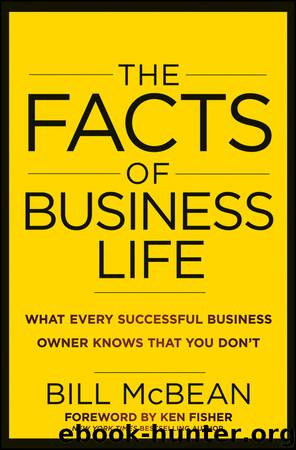The Facts of Business Life by Bill McBean

Author:Bill McBean
Language: eng
Format: epub
Publisher: John Wiley & Sons, Ltd.
Published: 2012-08-22T04:00:00+00:00
Protecting Tangible and Intangible Assets at Level 5
Protecting both tangible and intangible assets at Level 5 is as important—and works the same way—as at Level 4. In fact, some argue that it’s even more important that you pay attention to it at this point because, as you prepare to leave, it is easier to become distracted and forget about it. And Level 5 is definitely not the time for you to back off asset protection. It’s the time to make sure it continues so you can show a buyer the added value it provides him or her in the way the business is operated, or pass on to your successor a great business with no surprises.
Ultimately, every business has three types of assets—real estate, goodwill or blue sky, and tangible and intangible assets. Regardless of how you choose to exit the business, at Level 5 it is your responsibility to determine the value of those assets. The most important thing to remember in doing so is that the value must be justifiable and connected to reason. This is an important part of the exit for several reasons. First, the value placed on assets will determine the qualifications of potential buyers as well as potential successors. Second, asset values have to be justified not only to a buyer but also to a buyer’s lender. Third, in a succession, if a member of the family is picked to operate and own the business, a reasonable value has to be established on behalf of the family. That is, if the owner wants his or her successor to buy the business, the value established for it must be fair and justifiable to the other members of the family who will want their fair share of the pie. And, finally, the determined value of the assets will give you your “cash-out” financial position, which will indicate if you will have enough money to live well after your exit or you need more time to build up the business to a specific profit level before you can leave.
Determining the value of your assets can be something of a balancing act because your goal is to maximize your assets’ value while your buyer or successor wants to know that the value you’ve placed on those assets is supported by the business. For example, if there is real estate involved, the usual way its value is determined is by the owner, buyer, or successor having the land and/or the building appraised. However, even though such an appraisal might seem to be very straightforward, as with most things in business, it isn’t always so. If, for example, the value of the property has increased over the years and is now greater than the ability of the business to cover its cost, it creates a problem for the buyer or successor. This is a problem the owner has to solve, possibly by leasing the property to the new owner, selling the operating company and having the buyer/successor find other property, or finding a way to make up the difference in goodwill or operating asset values.
Download
This site does not store any files on its server. We only index and link to content provided by other sites. Please contact the content providers to delete copyright contents if any and email us, we'll remove relevant links or contents immediately.
Pioneering Portfolio Management by David F. Swensen(6194)
Man-made Catastrophes and Risk Information Concealment by Dmitry Chernov & Didier Sornette(5895)
Zero to One by Peter Thiel(5652)
The Motivation Myth by Jeff Haden(5136)
The Miracle Morning by Hal Elrod(4538)
Elon Musk by Ashlee Vance(4004)
The Art of Persistence: Stop Quitting, Ignore Shiny Objects and Climb Your Way to Success by Michal Stawicki(3609)
Unlabel: Selling You Without Selling Out by Marc Ecko(3570)
Delivering Happiness by Tony Hsieh(3349)
Urban Outlaw by Magnus Walker(3319)
Purple Cow by Seth Godin(3120)
Mastering Bitcoin: Programming the Open Blockchain by Andreas M. Antonopoulos(2964)
The Marketing Plan Handbook: Develop Big-Picture Marketing Plans for Pennies on the Dollar by Robert W. Bly(2927)
The Power of Broke by Daymond John(2857)
The Content Trap by Bharat Anand(2848)
Applied Empathy by Michael Ventura(2825)
The Airbnb Story by Leigh Gallagher(2769)
Keep Going by Austin Kleon(2675)
Radical Candor by Kim Scott(2635)
